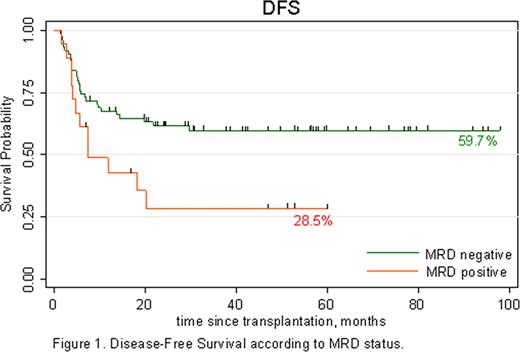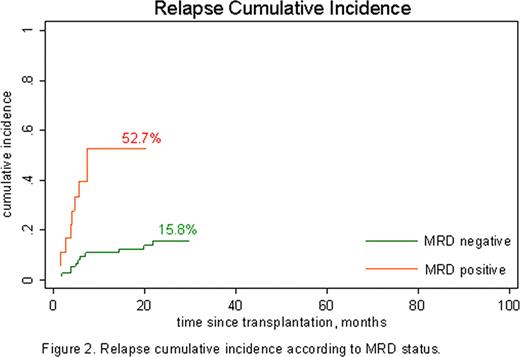Abstract
Abstract 4116
The main prognostic determinant of the outcome of allogeneic stem cell transplantation (allo-SCT) for acute myeloid leukemia (AML) is disease phase at transplant while the relevance of the assessment of minimal residual disease (MRD) at transplant has not been elucidated. Although molecular markers are highly sensitive for the detection of MRD, they are available in only half of AML cases to date. On the other hand, multiparametric flow cytometry (MFC) offers the feasibility of MRD assessment in virtually all patients. We retrospectively studied the influence of pre-transplant MRD status by MFC on the outcomes of patients with AML in relation to other known prognostic factors.
From 01/2003 to 12/2010, 102 AML patients (male/female; 58/44), aged 15–64 (median; 42) years, received allo-SCT in our center at first (CR1, N=69) or subsequent (CR≥2, N=33) morphologic complete remission. Donors were HLA-compatible siblings (N=45), matched unrelated (N=34) or alternative (haploidentical relatives or unrelated cord blood; N=6 and 17, respectively). The conditioning regimen was myeloablative in 85 (83.33%), and reduced-intensity in 17 (16.67%) cases. Data on MRD assessment by four- or five-color MFC before transplant were available in 92 patients. MRD was defined as any percentage of cells with an aberrant antigen expression pattern compared to normal or regenerating marrow. Transplant outcomes associated with MRD in univariate and multivariate analysis were overall (OS) and disease-free (DFS) survival, relapse incidence, and non-relapse-related mortality (NRM). Prognostic parameters included in the statistical model were the following: age and gender of recipient or donor, interval from diagnosis to transplant, de novo versus secondary AML, CR1 versus CR≥2 at transplant, cytogenetic risk group (according to Intergroup ECOG/SWOG definition), recipient and donor cytomegalovirus (CMV) serostatus, donor type, conditioning regimen (myeloablative versus reduced-intensity), degree of HLA match, method of graft-versus-host disease (GVHD) prophylaxis, and the modified European Blood and Marrow Transplantation Group (EBMT) risk score (Hemmati et al, 2011).
With a median follow-up of 47 (range, 6–98) months, OS and DFS were 54.2% and 51.72%, respectively. The cumulative incidence of relapse was 24.45%, and of NRM 23.82%. Eighteen out of 92 (19.57%) patients had MRD by MFC before allo-SCT. According to univariate analysis, the presence of MRD showed a negative association with OS (29.63% versus 63.17% at 4 years in patients with or without MRD, respectively, P=0.053) and DFS (28.52% in MRD-positive versus 59.74% in MRD-negative cases at 4 years, P=0.025, Figure 1). Presence of MRD correlated with higher incidence of relapse compared to MRD negativity (52.7% versus 15.8%, respectively, P=0.001) (Figure 2), but did not influence NRM. In multivariate analysis (Cox proportional hazards, backward stepwise selection), the parameters that remained independent adverse risk factors in terms of specific outcomes were: a) For OS: age and male gender of patient, alternative donor, unfavorable karyotype, CR≥2, and secondary AML, b) For DFS: presence of MRD (HR=3.2, P=0.009), CR≥2 (ÇR=3.1, P=0.005), reduced-intensity conditioning (HR=2.6, P=0.034), and unfavorable karyotype (HR=2.06, P=0.074), c) For relapse: presence of MRD (ÇR=3.83, P=0.003), and unfavorable karyotype (HR=3.55, P=0.007), and d) For NRM: age of recipient, CR≥2, and alternative donor.
In conclusion, the presence of MRD by MFC before allo-SCT for AML is associated with a significantly higher risk of relapse and an inferior DFS, despite morphologic complete remission at transplant. Moreover, pre-transplantation MRD status has independent prognostic significance in addition to the disease phase, cytogenetic risk group, and intensity of the conditioning regimen. Prospective studies are warranted to examine if the adverse impact of MRD on the outcomes of allo-SCT can be reversed by immunologic manipulations aiming at augmenting graft-versus-leukemia (GVL) effect.
No relevant conflicts of interest to declare.
Author notes
Asterisk with author names denotes non-ASH members.



